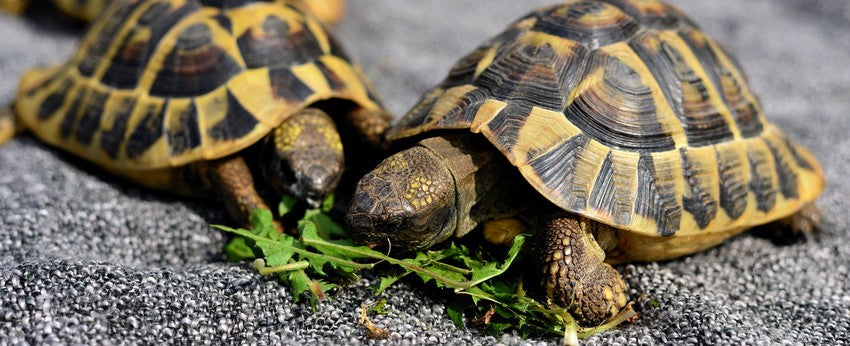
Everything you need to know about Hermann's tortoise
Do you want to adopt a Hermann's tortoise? Do you want to know how to raise a Hermann's tortoise? Do you want to easily recognize a male and female Hermann's tortoise?
Turtle Kingdom offers its expertise on Hermann's tortoises to answer all your questions. Regarding the tortoise, we can say that:
Hermann's tortoise, Testudo Hermanni, is a small to medium-sized tortoise found in southern Europe. Young animals, and in some cases adults, have a bright black and yellow pattern on the carapace (upper shield of the shell), but over the years the coloration fades and the shell becomes gray or yellowish. These tortoises are common in forests, scrublands, grassy plains, and farmland.
In this article, you will discover :
- Characteristics of Hermann's tortoise;
- The relationship between Hermann's tortoise and man;
- How to raise Hermann's tortoise.

Description of the species
Hermann's tortoise is a typical member of the genus Testudo . Both males and females have a large spike at the end of their tails. Adult males are smaller than females, but their tails are longer and thicker. This species is easily distinguished from the Testudo graeca , since the latter has a large spur on the thigh on its hind legs, which the former does not have. Hermann's tortoises are very active. In the morning and evening, in spring, summer, and autumn, they patrol their territory in the hope of chasing away a stranger or mating with a female.
Because Hermann's tortoises have a very active lifestyle, they should be provided with a large area where they can run, feed, hunt, dig, climb on rocks, sunbathe, hide in shelter, and have access to water. Tortoises need sunlight to develop and obtain calcium, especially for their shells.
Taxonomy and subspecies
After uncertain classification attempts over the years, Roger Bour identified and described two easily distinguishable subspecies of Hermann's tortoises in 1992. The western subspecies T. hermanni hermanni is common in northern Spain, southern France, northwestern Italy and some islands in the western Mediterranean.
These turtles are smaller and more colorful than those of the second subspecies. They are recognizable by a yellow spot on the head, behind each eye. The plastron (lower shield of the shell) is marked by two dark bands that run along the body. The eastern subspecies T. Hermanni Boettgeri Found in southern Italy, Albania, Greece, Yugoslavia, and the Balkans. These turtles are monotonous in color and have almost no spots, except for a few yellow spots behind the eyes (although some specimens do not have these).

Feeding the specimen
Hermann's tortoises are vegetarians and herbivores . They naturally feed on legumes, clover, lettuce and lupine, but they supplement their diet with snails, slugs, carrion, fruit, and even animal feces. They eat similar foods in captive conditions. Their appetite is excellent. Their favorite treats are figs, strawberries, and snails . Every two or three days they drink and take a bath.
The brightly colored turtles begin feeding 2 to 3 days after hatching, consuming the same food as adults. They need plenty of sunlight and young grass, which they eat eagerly.

Sex and reproduction of the Hermann tortoise in the natural environment
The couplings can be observed throughout the active season, but attendance becomes more intense in spring and towards the end of summer until autumn. During these periods, the males, very territorial, often fight among themselves. Like most turtles, females of this species also seem to have the ability to store sperm so that they can use it after years to continue producing fertile eggs .

Testudo Hermanni mating in captivity
In breeding conditions, turtles can mate all year round, but as in the wild, it is in spring and summer that the activity is most intense. courtship lasts several hours and consists of the turtles maneuvering in relation to each other and biting each other, and it can happen that the male seriously injures the female during the operation. As soon as the male places himself on the shell of the chosen one, he begins to emit particularly euphonious .

Risks in the natural environment
THE natural predators of our turtles are numerous, even if in reality the risk of being a potential prey decreases gradually depending on the age and size of the animal. However, it seems that occasionally, especially in Sardinia and the eastern area, turtles are preyed upon by birds of prey and corvids that catch them and carry them up high, only to drop them and eat them.
In our regions, the eggs in nests and young people up to 6-7 years old are most at risk of being preyed upon by corvids, rats, mustelids, felines, dogs, foxes, porcupines, wild boars, snakes, birds of prey and some other birds.

The secrets of the Hermann tortoise
The presence of land turtles is often betrayed by the noise produced by the violent clash of the shells of males against the females during courtship or by the hissing produced by the latter during mating. However, although it is often very difficult to observe these animals even in very populated places, the clues to follow may be different: in the case of environments characterized by the presence of dry vegetation , it is easy to hear the rustling of turtles' footsteps, or, in the case of a sandy substrate, it is not difficult to see the prints produced by their passage.
In addition, in places used for laying eggs, it is easy to find remains of turtle eggs scattered near the nests. The turtle can hibernate When the temperature is below 10°C. Land turtles have difficulty hibernating because the conditions for safe hibernation are difficult to establish. So try to maintain the right temperature to keep your pet active.

The relationship with man
In Europe, during the Middle Ages, turtles were eaten as a food granted during times of fasting and also sometimes the turtle broth was prescribed by doctors because it was believed to be curative. But the real threat to all wild turtle populations came from man in the 1960s and 1980s, when the destruction of natural habitats due to fires and anthropization , in addition to indiscriminate collection for commercial and ornamental purposes.
Today, the species is quite rare everywhere, and in any case localized, to the point of being supplanted in trade by T. graeca. It is currently protected, except in France, Italy and Greece; in certain regions of the Balkans, however, it is possible to capture a certain number of specimens each year, but their size must not exceed a certain limit.

Turtle Protection - Legal Status
Today, the eastern form is still widely distributed in the Balkans, while for the western form, the distribution is very small and fragmented. In order to limit the indiscriminate trade that has led to the extinction of many populations, reducing others to the limit of survival, all species of turtles (Greek tortoise, steppe tortoise, red-eared slider turtle, European pond turtle, giant tortoise, leatherback turtle, alligator snapping turtle, etc.) are now listed in Appendix II of the Washington Convention (CITES), which is followed by extensive legislation prohibiting their capture, trade and possession. It is an IUCN Red List of endangered species .

Captive breeding
The capture, trade and possession of Hermann's tortoises are prohibited by several national and international regulations. The regulation of the CITES . allows the possession of species limited to specimens in possession of the required documents, namely the certificate of detention attesting to the regular keeping or captive birth of specimens. Breeding in areas adjacent to those of natural distribution is not difficult if carried out in compliance with the biological requirements of the species.

Diseases
Adult turtles in the wild are quite hardy animals and generally they manage to heal with ease even serious injuries to the limbs or shell, surviving with severe mutilations. In captivity, the injured or obviously suffering animal must be visited and treated by a specialist.

Longevity
In the wild, the average lifespan is about 30-40 years, while in captivity it can reach 60-80 years, although in good conditions it can easily exceed a century of life.

Comparison and relationships with other species
The species is characterized by the horny case at the tip of the tail and the presence of two supracaudal plates; characters that distinguish it from all the more commonly bred exotic land turtle species: T. graeca, T. marginata and T. horsfieldi.
In terms of ecological conservation , cohabitation between these subspecies must be avoided at all costs because their reproduction would produce hybrid specimens and ultimately lead to the extinction of the basic species.

Sexual dimorphism
The plastron of males is concave and the supracaudal plates appear somewhat rounded due to an obvious inward curvature. In addition, the tail, much longer and wider at the base, reveals a slightly elongated cloacal opening positioned towards the tip of the tail itself.
Females, larger than males, have a taller carapace and a more elliptical shape than that observed in males. The shell is flat and the supra-caudal plates, straight and turned downward, hide a very short tail. The nails on the hind feet of females are very long, probably because they are used for digging the nest. Go to this article if you want to know for sure How to tell a male and female turtle apart .

Buy a Hermann tortoise
You can choose this species as a pet. To do so, you must contact licensed breeders. This is the only authorized way to obtain this species. reptile .
Make your choice safely
As you can see, Herman's tortoises make excellent pets. With an average lifespan of around 40 years, they can stay with you for many years. Herman's tortoises can mate year-round, but their mating season is more intense in spring and summer.
With all this information, we can safely say that you are now an expert on Herman's tortoises. You know exactly how to care for them and where to find them. However, to ensure the well-being of your Herman's tortoise, you will need quality food. If you would like to learn more about turtle feeding , we provide you with this blog article. From now on, you will have almost no difficulty recognizing a Hermann's tortoise and you will know exactly how to raise one.



2 comments
À quoi sert la tortue dans la nature
J aimerais tellement en avoir une .j en ai pas proche de chez